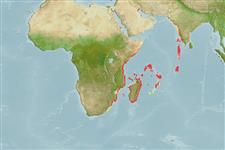分類 / Names
共通名の | 類義語 | Catalog of Fishes(部類, 種) | ITIS | CoL | WoRMS | Cloffa
>
Acropomatiformes (Oceanic basses) >
Pempheridae (Sweepers)
Etymology: Parapriacanthus: Greek, para = near + Greek, prion = saw + Greek, akantha = thorn (Ref. 45335); punctulatus: Name from Latin 'punctulatus' for dotted; referring to the profusion of dark dots on the side of the body below the lateral line that extend well posterior to the origin of the anal fin; these dots are more evident on preserved specimens than in life..
Environment: milieu / climate zone / depth range / distribution range
生態学
海 関連する礁; 深さの範囲 16 - 61 m (Ref. 107896). Tropical
Western Indian Ocean: wide-ranging from South Africa (KwaZulu-Natal) and Mozambique to the Comoro Islands, northern Madagascar, Seychelles, the Mascarene Ridge, and the Mascarene Island of Réunion.
サイズ / 重さ / 年齢
Maturity: Lm ? range ? - ? cm
Max length : 6.7 cm SL オス/雌雄の選別がない; (Ref. 107896); 5.0 cm SL (female)
簡単な記述
検索表 | 形態学 | 形態計測学
背面の脊椎 (合計) : 6; 背鰭 (合計) : 9; 肛門の骨: 3; 臀鰭: 20 - 23. This species is characterized by the following: D VI,9; A III,21 (20-23); pectoral-fin rays 16 (15-17); lateral-line scales 69 (63-72); scale rows above lateral line to base of dorsal fin 5.5; gill rakers 24 (23-26, modally 25); body depth 3.2 (3.25-3.35) in SL, width 2.1 (2.0-2.2) in body depth; depth of caudal-peduncle 10.4 (8.9-9.6) in SL; head length 2.95 (2.8-2.9) in SL; snout length 11.4-13.0 in SL; mouth forming an angle of about 60° to horizontal axis of body; sharply conical, recurved teeth in 2 irregular rows in upper row more forward-projecting, those of second row more strongly recurved; similar smaller teeth in lower jaw, well-spaced, in a single row; very small, incurved, sharply conical teeth in a single irregular row on vomer and palatines; thin lips, covered with closely adjacent papillae; tongue broadly triangular, indented indented on side near tip, forming a small, half-round, flexible flap; predorsal length 2.3 (2.3-2.4) in SL; first dorsal-fin soft ray is longest, 5.3 (4.7-5.4) in SL; caudal fin forked with fin length 4.5 (3.6-4.3) in SL; pectoral-fin length 3.5 (3.25-3.6) in SL; prepelvic length 2.7 (2.5-2.7) in SL; pelvic fins not reaching the anus, fin length 5.9 (5.1-6.5) in SL; preanal length 1.5 (1.5-1.6) in SL; without a pin-like dark line anterior to anus; instead a very dark blue band with a median dull pink streak that narrows anteriorly; black iris in preserved holotype (Ref. 107896).
Stomach contents include a half-digested polychaete about 45 mm by 5 mm, along with copepods, crustacean larvae, and small fishes (Ref. 107896).
Life cycle and mating behavior
Maturities | 繁殖 | Spawnings | Egg(s) | Fecundities | 幼生
Randall, J.E. and S.V. Bogorodsky, 2016. Preliminary review of the pempherid fish genus Parapriacanthus of the western Indian Ocean, with descriptions of five new species. J. Ocean Sci. Found. 20:1-24. (Ref. 107896)
Human uses
用具
特記事項
XMLをダウンロードして下さい
インターネットの情報源
Estimates based on models
Phylogenetic diversity index (Ref.
82804): PD
50 = 0.5005 [Uniqueness, from 0.5 = low to 2.0 = high].
Bayesian length-weight: a=0.01479 (0.00642 - 0.03409), b=3.02 (2.82 - 3.22), in cm total length, based on LWR estimates for this (Sub)family-body shape (Ref.
93245).
栄養段階 (Ref.
69278): 3.3 ±0.4 se; based on size and trophs of closest relatives
回復力 (Ref.
120179): 高い, 15か月以下の倍増期間の最小個体群 (Preliminary K or Fecundity.).
Fishing Vulnerability (Ref.
59153): Low vulnerability (10 of 100).
